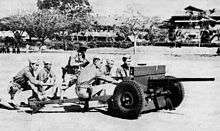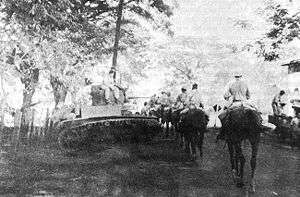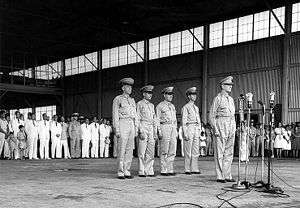United States Army Forces in the Far East
| United States Army Forces in the Far East (USAFFE) | |
|---|---|
|
Lt. Gen. Douglas MacArthur conducts a ceremony formally inducting the Philippine Army Air Corps into United States Army Forces in the Far East at Camp Murphy, Rizal on 15 August 1941. Behind MacArthur, from left to right, are: Lt. Col. Richard K. Sutherland, Col. Harold H. George, Lt. Col William F. Marquat, and Maj. LeGrande A. Diller. | |
| Active | July 26, 1941 – June 30, 1946 |
| Country |
United States Of America Commonwealth of the Philippines |
| Branch | Regular Army |
| Part of | United States Department of War |
| Commanders | |
| Notable commanders | General Douglas MacArthur |
United States Army Forces in the Far East (USAFFE) was a military formation of the United States Army active from 1941 to 1946. The new command's headquarters was created on July 26, 1941, at No. 1, Calle Victoria, Manila, Luzon, the Philippines, with General Douglas MacArthur as commander. The Chief of Staff was Brigadier General Richard K. Sutherland and the Deputy Chief of Staff was Lieutenant Colonel Richard J. Marshall. The core of this command (including MacArthur, Marshall, and Sutherland) was drawn from the Office of the Military Advisor to the Commonwealth Government.
Creation of this command led to the subordination of the headquarters of the Philippine Department of the U.S. Army, as a service command, since planning and tactical control were now under USAFFE control. MacArthur explains, "It became an administrative echelon. It was analogous to a corps area".[1] MacArthur recommended that Philippine Department commander Major General Grunert be reassigned, as his services were no longer needed. On October 23, Grunert returned to the United States and MacArthur was temporarily appointed as the Philippine Department's commander.
History
In January 1941, the intelligence officer (G-2) of the Philippine Department had recommended, to his superior in Washington, D.C., that an American high command in the Far East be created, with the commander of the Philippine Department as the designated commander of said command. It does not appear this idea was seriously considered until Douglas MacArthur suggested, to the Army Chief of Staff, that such a command be created with MacArthur as the Far Eastern Commander.
On June 6, Acting Chief of the War Plans Division Brigadier General Leonard T. Gerow noted that he saw no need for such a command, as US Forces in the Far East were concentrated in the Philippines. As such, Gerow argued that should a "crisis" occur, then MacArthur should become the commander of, not some new command, but rather, of the Philippine Department itself.

On June 20, Army Chief of Staff George C. Marshall informed MacArthur, "Both the Secretary of War (Stimson) and I are much concerned about the situation in the Far East. Your qualifications and experience make you the logical selection for the Army Commander in the Far East should the situation approach a crisis. The Secretary has delayed recommending your appointment as he does not feel the time has arrived for such action. At the proper time, he will recommend to the President that you be so appointed."

On July 17, Gerow made the following recommendations:
- The President should call into the service of the United States all organized military forces of the Commonwealth of the Philippines;
- General MacArthur should be called to active duty as a Major General and assigned as commander of Army Forces in the Far East;
- $10,000,000, from the President's Emergency Fund should be allotted to cover the costs of mobilization and training of the Philippine Army;
- Training of the Philippine Army be financed from the sugar excise fund, or from other funds; and
- 425 U.S. Army reserve officers be sent to the Philippines to assist in mobilization and training.
On July 25, Secretary of War Henry L. Stimson requested that President Roosevelt issue orders calling the military forces of the Commonwealth into active service for the United States. Stimson explains, "All practical steps should be taken to increase the defensive strength of the Philippine Islands". The following day, Roosevelt froze all Japanese assets within the United States and issued the orders to absorb the forces of the Philippine Army. That same day, the War Department created the USAFFE command, with jurisdiction over the Philippine Department and the military forces of Commonwealth of the Philippines (seemingly principally the Philippine Army, with two regular and ten reserve divisions). At the same time, MacArthur was recalled to active duty as the USAFFE commander, from his positions as military advisor to the Philippine government and Field Marshal of the Philippine Army.
The short-lived American-British-Dutch-Australian Command (ABDACOM) was formed on January 1, 1942, to control all Allied forces in South East Asia and the South West Pacific. ABDACOM nominally controlled USAFFE forces, although the latter was effectively an independent force.
In March, due to the worsening Allied position in Asia and the Pacific, Roosevelt ordered MacArthur to relocate his command to Australia. MacArthur's famous speech regarding the Philippines, in which he said, "I came out of Bataan and I shall return" was made at Terowie, South Australia on March 20. General Jonathan Wainwright officially assumed control of the remaining forces in the Philippines, now known as United States Forces in the Philippines (USFIP) on 23 March.
On April 18, 1942, ABDACOM was replaced by General Headquarters (GHQ), Southwest Pacific Area (SWPA) in Melbourne, Australia, including USFIP. MacArthur was appointed Supreme Commander, SWPA. USFIP, with the exception of some ad hoc guerilla and resistance outfits, had surrendered to Japanese by May 8.
MacArthur formally reconstituted USAFFE in Australia in February 1943, to assume responsibility for all administrative staff duties pertaining to U.S. Army units in the SWPA, as well as control of guerrilla forces in the Philippines.
On October 20, 1944, the recapture of the Philippines commenced when Allied forces landed in Leyte Gulf. The campaign was declared completed on July 4, 1945.
USAFFE was formally dissolved in the lead-up to Philippine independence on July 4, 1946.
Order of battle
July 31, 1941
Total Strength—22,532 (1,434 officers—21,098 enlisted, including 11,937 Philippine Scouts)
- USAFFE Headquarters (5)
- Philippine Department Headquarters (289)
- Philippine Division (10,473)
- Harbor Defenses of Manila and Subic Bays (5,360)
- Philippine Army Air Corps (2,407)
- 26th Cavalry Regiment (838)
- 43rd Infantry Regiment (329)
- U.S. 86th Field Artillery Regiment (PS) (388)
- U.S. 88th Field Artillery Regiment (PS) (518)
- U.S. 808th Military Police Company (69)
- Service Detachments (1,836)
- Other (20)
November 30, 1941
Total Strength: 31,095 (2,504 officers and 28,591 enlisted, including 11,957 Philippine Scouts)
- USAFFE Headquarters (61)
- Headquarters, Philippine Department (553)
- Headquarters - North Luzon Force (38)
- Headquarters - South Luzon Force (10)
- Headquarters - Visayan-Mindanao Force (9)
- Philippine Division (10,233)
- Harbor Defenses of Manila and Subic Bays (5,225)
- Far East Air Force (5,609)
- 26th Cavalry Regiment (PS) (842)
- 43d Infantry Regiment (PS) (328)
- U.S. 86th Field Artillery Regiment (PS) (395)
- U.S. 88th Field Artillery Regiment (PS) (538)
- U.S. 200th Coast Artillery (AA) Regiment (1,809)
- U.S. 192d Tank Battalion (588)
- U.S. 194th Tank Battalion (410)
- U.S. 808th Military Police Company (160)
- Service Detachments (4,268)
- Other (19)
See also
References
- ↑ HyperWar notes source as 'Extract of rad from CG USAFFE in memo, Jah Gen William Bryden, DCofS for ACofS G-1, 13 Oct 41, OCS 18136-78; see also memo, Bryden for WPD, 7 Oct 41, OCS 18136-71.'
External links
- National Archives, Timeline [Philippine Archives Collection].
- HyperWar, U.S. Army Forces, Far East
- Orbat.com, USAFFE December 1941
- United States Army, Final SWPA operations and organization of AFPAC, extracted from MacArthur Reports, Center for Military History
